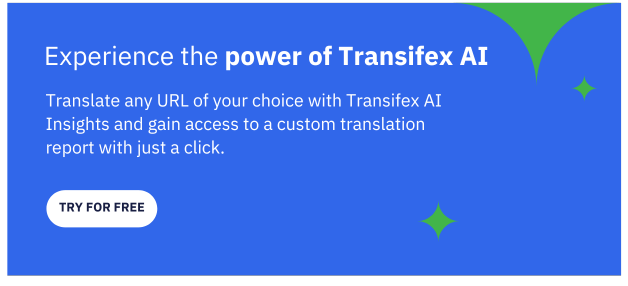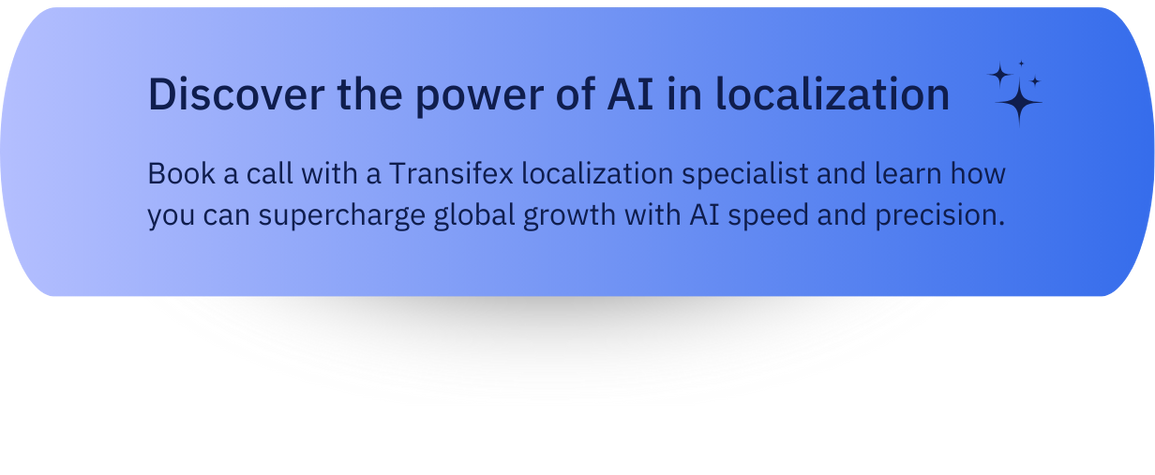If you want to expand into foreign markets, translating your website is one of the first things you should consider. There are several translation methods and tools you can leverage.
But, with so many options, you might feel overwhelmed.
Rest assured, this article answers all the questions you may have, including: What are the best translation techniques? What are the differences between them? And what translation methods can you use to translate your website into different languages?
Let’s begin!
Direct translation techniques VS indirect translation techniques
You can choose either a direct or an indirect translation technique to translate your website. But what’s the difference between them?
Direct translation techniques are recommended when the sentence structure of the source language can be used in the target language with the same meaning.
Indirect translation techniques (or oblique translation techniques) are recommended when the source language is very different from the target language text. This means you should take several cultural nuances into account.
Also, it would be best if you made the appropriate changes in the text’s structural or conceptual elements and grammatical structure, ensuring the meaning is preserved in the foreign language.
| Direct translation techniques | Indirect translation techniques |
|---|---|
| Literal | Modulation |
| Borrowing | Transposition |
| Calque/ Loan translation | Equivalence/ Reformulation |
| Compensation | |
| Adaptation | |
| Reduction | |
| Transcreation |
Which are the direct translation techniques?
The direct translation techniques are literal translation, borrowing, and calque. Let’s see each technique’s unique characteristics!
#1 Literal translation
Literal translation is an accurate and straightforward word-for-word translation technique. The original text is translated directly into the target language, maintaining its meaning, grammar, and structure.
One can’t use literal translation for every language, as it doesn’t consider the original text’s nuances. However, it is suitable for languages with similar syntax rules and cultural characteristics.
#2 Borrowing
In borrowing, the original text’s words, phrases, and expressions from the source language are used intact in the target language text.
One can use this technique when the words or phrases on a multilingual website don’t have an equivalent in the target languages. Examples of borrowed English words are:
- Robot (borrowed from Chez)
- Zero (borrowed from Arabic)
- Hamburger (borrowed from German)
#3 Calque/ Loan translation
Although calque is similar to borrowing, those two translation techniques differ. In calque, the borrowed word is translated into the target language, while in borrowing, the word remains the same.
Calque works best with words and phrases that can be translated without losing their original meaning. For example, in English, ‘Adam’s apple’ can be translated into French as ‘pomme d’Adam’.
However, it should not be used for phrases that are difficult to understand or that cannot be translated literally from one language to another.
What are the indirect translation techniques?
Indirect translation techniques help adjust a website’s original texts to match the target audience’s grammatical rules and cultural nuances by changing structural and conceptual elements.
Choosing the right indirect translation technique can make all the difference in engaging with foreign audiences and breaking language barriers. It ensures the preservation of a brand’s messaging!
The oblique translation techniques are modulation, transposition, equivalence/reformulation, compensation, adaptation, reduction, and transcreation. What are the differences between them?
#1 Modulation
In modulation, a different phrase is used in the target language than in the original language, aiming to express the same meaning. For example, the English word ‘lifestyle’ can be translated into French as ‘train de vie’.
Although literal translation may be grammatically correct, adapting it to the target language with modulation makes it sound more natural. That makes the text easier to read and understand, ensuring the reader won’t be confused by phrases that sound unnatural!
#2 Transposition
In transposition, the order of the words in a sentence changes to match the grammatical and syntax rules of the target language. In other words, the original meaning is preserved, but the original sentence structure is modified. For example, ‘red ball’ is translated as ‘boule rouge’ in French.
Transposition is a good option for languages with different grammatical structures. Nevertheless, the translator must be familiar with the rules of the target culture to make the appropriate changes in the words’ order.
#3 Equivalence/ Reformulation
Like modulation, equivalence or reformulation aims to find the equivalent of an original phrase in the target language without changing the meaning.
A form of idiomatic translation, equivalence/reformulation uses creative ways to preserve the meaning of the source language’s phrases. It is one of the most popular oblique translation techniques used in marketing translation, as local idioms or expressions can be translated to make sense to the target audience!
#4 Compensation
When a word or phrase can’t be translated into the target language, compensation is a good option. Translators who use compensation find ways to express the meaning of these words or phrases in another part of the text. This way, they help readers understand the nuances that can’t be translated literally.
An example of this is the different words used in several languages to express the word ‘you’, depending on the level of formality. The French, for instance, use the word ‘tu’ for informal conversations and the word ‘vous’ for formal.
Of course, the translator needs to know the cultural context and nuances of the target language and the source language to translate the text in a culturally appropriate manner.
#5 Adaptation
Similar to the equivalence/reformulation translation method, in adaptation, the translator translates the original text considering the cultural context of the target language. That means the translated text should sound natural to native readers while preserving the original meaning.
To achieve that, the translator should adapt many phrases, idioms, and jokes to the target audience’s culture so that they can understand them.
#6 Reduction
In reduction, the translator cuts words or phrases considered redundant in the target language. This translation technique requires experience and precision, as there’s always the risk of important information and messages being lost in translation.
Thus, the translator should be careful and remove only what’s unnecessary, ensuring the original message is preserved in the translated text!
#7 Transcreation
Transcreation combines translation and creation to adapt the original text to the cultural context of the target language. In transcreation, translators don’t simply translate the text but create a new one, maintaining the context, tone, and intent.
The main advantage of this technique is that the new text keeps the original message and the emotions associated with it while resonating with the target audience. This helps brands create culturally relevant website content that boosts user engagement.
The best translation methods for websites
There are 3 popular translation methods you can use for translating your website as part of your localization strategy.
#1 Human translation
Human translation is done by professional translators or native speakers familiar with the nuances of the target and the source language.
The main advantages of human translation are:
- Highly accurate translation method
- The best option for fields that require technical translation
- Very creative
- The translated text can be adapted to different tones of voice and writing styles
- Can be used for SEO-friendly content creation
- Aligned with the context
- Effectively communicates the brand’s message to the target language
#2 Machine translation (MT)
Contrary to human translation, machine translation is done by computer programs that can translate content automatically.
The biggest advantages of machine translation are:
- The translation process is fast
- Can detect and translate the entire content of a website
- Cost-effective word-for-word translation approach
- The translated text can be post-edited
- Good option for websites with a large number of pages
#3 Machine translation post-editing (MTPE)
Machine translation post-editing is the combination of human and machine translation. This method marries the benefits of the two methods, offering a high accuracy level while being fast and cost-effective.
In machine translation post-editing, the text is initially translated by a machine translation engine and then edited and perfected by human translators. Machine translation post-editing (MTPE) is popular because it combines the speed of machine translation with the linguistic and cultural knowledge of human translators!
#4 AI-driven translation and QA
While human and machine translation offers valuable solutions, AI-powered translation takes it a step further. It utilizes advanced neural networks and machine learning to improve continuously, analyzing vast amounts of data to deliver accurate and natural-sounding translations.
This method provides several advantages:
-
Superior Quality: AI uses historical data and continuous learning to enhance the quality and speed of translations over time. It adapts to feedback and evolving language usage, ensuring that translations remain current and relevant.
-
Scalability and Speed: AI can handle massive volumes of text quickly and efficiently, making it ideal for businesses with ever-growing content needs.
-
Cost-Effectiveness: AI can streamline QA/review workflows and automate translations, minimizing human interference and consequently reducing translation and transcreation costs compared to traditional methods.
While the speed and cost benefits of AI-driven translation are undeniable, there’s a valid concern: the potential loss of nuance, cultural sensitivity, and brand-specific voice. Generic machine-generated content won’t win hearts and minds in a new market. For truly effective localization, you need an AI tool, like Transifex, that is specifically designed to produce human-quality content tailored to your unique needs.
By leveraging your glossary, translation memory, company profile, and labeled training data, Transifex provides a differentiated experience compared to simply being a front-end to LLMs or MT engines.
How can Transifex help you translate your website?
Do you want to translate your website into the languages your target audience speaks and expand your brand across the globe?
At Transifex, we help you streamline the translation process of your website from one language to another with precise AI-powered human-quality translations that reduce time-to-market.
Use the powerful Transifex AI tool now and start creating culturally relevant SEO-friendly content that resonates with your target audience!
Sign up for a free trial today and expand globally with the power of AI.
FAQs
What are the most common translation methods?
The most common translation methods are machine translation, human translation, and machine translation post-editing.
What type of translation is most difficult?
The most difficult translation is the translation of idioms, expressions, and grammatical structures unique in every target language. Machine translation can’t translate those accurately, so a human translation or a review by a professional human translator is mandatory.
Should I translate my URLs?
Besides the text of your website, you should also translate its URLs to enhance user experience and boost your SEO efforts, which may make your site rank better in search engines.
What languages are the most needed for translation?
English and Spanish are the most widely spoken languages in the world, so translating your website into those two languages can help you expand in various global markets.











